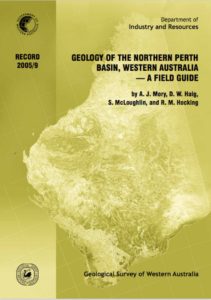- Geology of the Northern Perth Basin
Locality 3: Stone Wall, Murchison
House Station
Summary: Good exposures of fluvial redbed facies of the Ordovician Tumblagooda Sandstone, overlain by Cretaceous Winning Group and Toolonga Calcilutite.
Location: About 18 km north-northeast of Kalbarri, MGA 228600E 6946600N, GANTHEAUME.
Access: Drive to Murchison House Homestead (off the Ajana–Kalbarri Road), cross the river at the station causeway, turn north after 800 m, just past a small duricrust outcrop, follow the track 8 km north, turn west on a prominent firebreak and drive 1 km along the south side of the gully. Park just below the outcrop of the Tumblagooda Sandstone with a low stone wall (MGA 229030E 6946520N) on it, and walk up the gully. Dual- range four-wheel drive is necessary past the homestead, and some sections of the track consist of very soft sand, so tyres may need to be deflated significantly. Contact Murchison House beforehand (08 9937 1998). The locality is listed with the National Estate as an ‘indicative place’ (Place ID: 18749).
Geology: The upper part of the Tumblagooda Sandstone (Fig. 9), and a Cretaceous section (Fig. 10) comprising the Birdrong Sandstone, Windalia Sandstone Member of the Muderong Shale, Windalia Radiolarite and Alinga Formation of the Winning Group, and the Toolonga Calcilutite are present in the creek and breakaways immediately above the springs at Stone Wall on the edge of the Pillawarra Plateau (Fig. 11).
The Tumblagooda Sandstone exposed here is primarily FA3 (Fig. 9). FA4 is present at the top of the Ordovician section, but is not well exposed. The section consists of poorly cyclic, coarse-grained, trough cross-bedded sandstone, and is typical of the upper part of FA3. The Gabba Gabba Member is about 20 m above the base of the section, just above the first terrace level. The lowest occurrence of scattered vertical burrows (Cylindricum) is at about the level of the member, and palaeocurrent directions abruptly shift from 300–350° below the marker to 230–280° above the marker.
The right-hand branch in the gully at the top of the Tumblagooda Sandstone has more continuous exposure of the basal part of the Cretaceous Birdrong Sandstone. The very poorly consolidated to unconsolidated, light- grey quartz sandstones are about 33 m thick. The lower 12 m is massive to very poorly horizontally bedded and dominantly coarse grained. This is overlain by 15 m of indistinctly cross-bedded, medium- and coarse-grained sand, 4 m of very coarse-grained sand and, at the top, 2 m of clayey, glauconitic sandstone. Weakly silicified fossil wood with Teredo borings, and rare ammonites, have been found at the top of the sandstone, which is tentatively correlated with the Windalia Sandstone Member of the Muderong Shale. Below this level, deposition is assumed to have been in shoreface to coastal environments; the sequence does not have many environmentally diagnostic features. Numerous plesiosaur bones, sufficient for reconstruction of a skeleton, have been recovered from the top of the sandstone in the southern gullies at Stone Wall (Cruikshank and Long, 1997).
Beds of compact radiolarian mudstone that belong to the Windalia Radiolarite overlie the sandstone. These are distinguishable by their low density, and that they form minor bluffs in the section. There are excellent sections of both the Windalia Radiolarite and Alinga Formation in several gullies along the scarp of the Pillawarra Plateau toward Thirindine Point. The Windalia Radiolarite is up to 16 m thick and overlain, in turn, by friable glauconitic sandstone of the Albian part of the Alinga Formation, up to 6 m thick. The Cenomanian part of the Alinga Formation (about 1 m thick) consists of glauconitic claystone and is equivalent to the upper Gearle Siltstone elsewhere in the Southern Carnarvon Basin. Both the Alinga Formation and Windalia Radiolarite are low-energy, sub-wave-base, inner neritic deposits (Haig, 2005).
The Toolonga Calcilutite rests disconformably on the Alinga Formation. Phosphate nodules locally mark the contact. It is about 25 m thick and consists of very fossiliferous, white-weathering calcilutite and calcisiltite containing abundant small fragments of Inoceramus, a giant bivalve. The formation was deposited below wave base on a low-energy marine shelf, after global oceanic circulation had adjusted as a result of Gondwana fragmentation to a situation of minimal terrigenous influx along the western Australian coastline.

